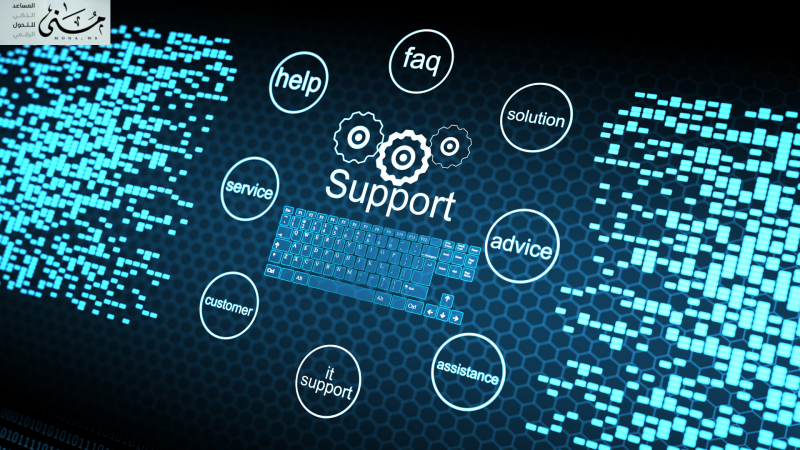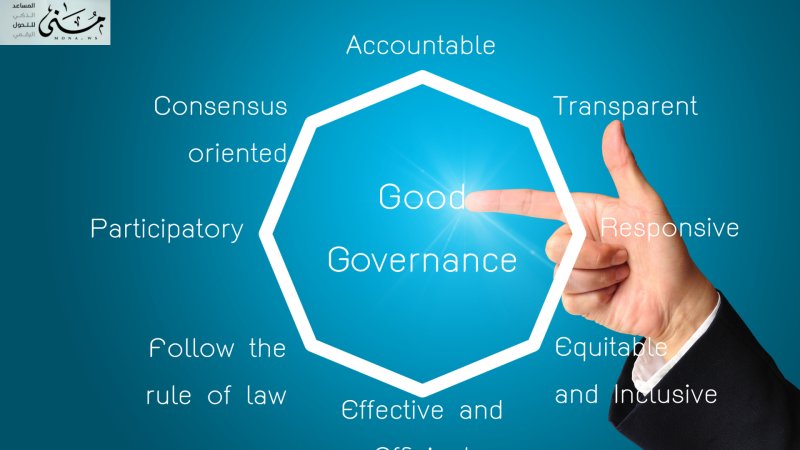Compliance with international standards has become a fundamental necessity for organizations seeking to achieve good governance. Modern administrative systems play a pivotal role in facilitating this task, by providing technological tools that help organizations organize their operations, enhance transparency, and adhere to international laws and standards.
This article highlights the importance of digital governance in achieving compliance.
What is the concept of compliance?
Compliance is defined as adherence to laws, policies, and procedures that regulate the work of institutions, whether internal or external. This means that the institution operates in accordance with local and international standards and legislation, including governance regulations, cybersecurity, and data protection.
Corporate compliance requires an effective management system to monitor compliance, detect deviations, and take corrective action. Compliance is not just a legal obligation, but is also a key factor in building an organization’s reputation and the trust of its stakeholders.
What is digital governance and its role in achieving compliance?
Digital governance is defined as an administrative and technical system that aims to use digital technology to enhance decision-making processes, improve transparency, and ensure efficiency in resource management within institutions.
This approach focuses on using digital tools such as document management systems, artificial intelligence, and data analytics, to ensure that corporate policies and procedures are implemented in a transparent and fair manner that is in line with local and international standards.
Digital governance contributes to improving the interaction between different parties within organizations, such as employees, customers, and investors, while enhancing the capabilities of organizations to meet emerging challenges.
In short, digital governance and compliance are two complementary elements that contribute to achieving transparency, sustainability, and effective risk management within organizations.
The importance of digital governance lies in its ability to enhance institutions’ compliance with international standards, whether in the public or private sector, as it ensures the existence of unified and transparent systems for dealing with data, standardizing procedures, and implementing policies in accordance with international standards.
For example, organizations that adopt digital governance can improve their handling of systems such as quality management standards (ISO 9001) or data protection standards such as the General Data Protection Regulation (GDPR).

Important statistics that show the impact of digital governance
According to a 2023 World Bank report, countries that adopted digital governance policies saw government sector productivity grow by 25% compared to countries that still rely on traditional methods.
At the private sector level, a study conducted by McKinsey showed that organizations that rely on digital governance systems were able to reduce operational risk by 40%, while increasing operational efficiency by 30%.
These numbers are not just statistical results, but rather show the importance of linking digital governance with institutions’ compliance with international standards. For example, financial sector institutions that implement digital governance have succeeded in reducing regulatory violations, which has led to a reduction in financial penalties imposed on them.
The evolution of digital governance and its impact on compliance
The concept of digital governance began to emerge with the technological revolution at the beginning of the twenty-first century, but its development took a more influential turn with the emergence of technologies such as artificial intelligence, big data analysis, and blockchain technologies.
Digital governance has evolved from mere electronic tools to integrated systems that manage complex and intricate processes automatically and efficiently. Today, developed countries and major companies rely on digital governance to achieve compliance with strict standards in the areas of the environment, occupational safety, and corporate governance.
Adopting AI to analyze administrative processes helps organizations identify gaps in compliance with international standards and proactively address them.
How does digital governance contribute to compliance?
Digital governance contributes to achieving compliance through several foundations, which are:
Transparency and reducing human errorDigital governance provides technology-based systems to analyze data and ensure transparency, reducing human assessment errors.
Integration with international standardsDigital governance facilitates the integrated application of standards through accurate reporting that is in line with international requirements.
Risk managementDigital governance enhances risk management systems, enabling organizations to detect and address errors and deviations early.
digital governance is a cornerstone for achieving compliance with international standards, not only because it enhances efficiency and transparency, but because it is a strategic tool for keeping pace with global changes and achieving institutional leadership.
What are the international standards related to governance?
International standards related to governance represent the framework that defines the principles and foundations that must be followed to ensure transparency, efficiency, and compliance in administrative and financial operations, whether at the level of institutions or governments. The following is an explanation of the most prominent international standards related to governance:
- standardISO 26000: Social Responsibility
the goal: Guiding institutions to implement ethical and socially responsible practices within their activities.
Application: Focuses on issues such as human rights, labor practices, environmental governance, and business ethics.
Its importance in governanceThis standard helps organizations adopt policies that balance profit objectives with responsibility towards society and the environment, enhancing organizations’ compliance with global sustainability principles.
- standardISO 31000: Risk Management
the goal: Provide principles and guidelines for managing risks strategically and systematically.
Application: Used to identify potential risks, analyze them, and develop strategies to mitigate them.
Its importance in governanceThis standard is essential to enable organizations to make informed decisions based on a comprehensive risk assessment, enhancing their transparency and credibility.
- standardISO 9001: Quality Management
the goal: Improving the quality management system within organizations to ensure the provision of products and services that meet customer expectations and international standards.
Application: Focuses on improving internal processes and raising operational efficiency.
Its importance in governance: Helps enhance transparency and efficiency, and enables organizations to achieve compliance with regulatory requirements.
- standardISO 27001: Information Security Management
the goal: Develop a framework for managing and protecting sensitive data and information within organizations.
Application: Includes analyzing information security risks and developing strategies to protect them.
Its importance in governance: It is necessary to ensure data protection and compliance with laws relating to information security such as the General Data Protection Regulation (GDPR).
- standardGRI: Sustainability Reporting
the goal: Provide guidance for transparent reporting on the environmental, social and economic performance of institutions.
Application: Focuses on providing a clear picture of the impact of corporate activities on the environment and society.
Its importance in governanceThis standard enhances organizations’ ability to communicate effectively with stakeholders, building trust and helping to comply with international sustainability standards.
- OECD Corporate Governance Principles (OECD)
the goal: Identifying the guidelines needed to enhance corporate governance at a global level.
Application:It includes issues such as shareholder rights, transparency, and disclosure of financial and non-financial information.
Its importance in governanceThese principles provide a comprehensive framework for promoting good governance within companies and institutions, ensuring their compliance with international standards.
- standardISO 14001: Environmental Management
the goal: Providing a framework for managing the environmental impact of organizations and achieving environmental sustainability.
Application: Focuses on reducing the environmental footprint and achieving corporate compliance with local and international environmental regulations.
Its importance in governance: Helps organizations achieve compliance with environmental laws and improve their image in front of society and stakeholders.
These international standards are essential tools for ensuring effective governance, as they not only focus on improving the internal performance of institutions, but also enhance compliance with global standards.
The importance of management systems in achieving compliance with international standards
Management systems are the frameworks and tools adopted by institutions to ensure that work proceeds in an organized manner and in line with strategic objectives. These systems are one of the vital elements in achieving institutions’ compliance with international standards. The importance of management systems in compliance with international standards is represented in:
Unification and organizationManagement systems standardize processes within an organization, making it easier for executive teams to understand and achieve goals according to required standards.
Promote transparencyManagement systems contribute to transparency by providing tools to document and monitor processes, which helps in compliance with international transparency requirements.
Reduce riskBy focusing on risk management (ISO 31000) These systems help organizations predict and solve problems before they become crises.
quality assuranceSystems such as:ISO 9001 improves quality in processes and services, enhancing organizations' compliance with international standards.
Environmental SustainabilitySystems such as:ISO 14001 enables organizations to achieve compliance with global environmental standards, supporting sustainability and improving their relationship with society.
Systems that help achieve compliance with international standards
Modern management systems are vital tools to ensure that organizations comply with international standards, especially in the field of governance. With the diversity of available systems, their advantages and methods of implementation vary based on the needs of organizations. Below is a comparison between some global systems that help organizations achieve digital governance:
- systemSAP Governance, Risk, and Compliance (GRC)
An integrated system focused on governance, risk and compliance management, helping organizations verify compliance with regulatory laws and mitigate risks.
- systemMicrosoft Compliance Manager
A management system that integrates data security and compliance tools, designed to support organizations in adhering to standards such as:ISO 27001 and GDPR.
- systemMetricStream Governance, Risk, and Compliance
Integrated governance, risk and compliance management solutions, widely used in large enterprises.
- systemDocSuite
DocSuite is a modern management system that focuses on intelligent document management, organization of administrative communications and automation of processes. It is specially designed to comply with international standards and helps organizations achieve transparency and efficiency.
DocSuite is designed to support compliance with standards such as:ISO 9001, ISO 27001, and ISO 14001, making it a comprehensive choice for organizations seeking compliance with international standards.
Main Features:
- Centralized and secure document management.
- Automate internal processes to bring organizations into compliance with standards such as:ISO 9001 and ISO 27001.
- Easy-to-use interface, suitable for organizations of all sizes.
- Real-time reports to track performance and analyze compliance.

Detailed comparison between the most important systems
|
Feature |
SAP GRC |
Microsoft Compliance Manager |
MetricStream GRC |
DocSuite |
|
Document management |
Advanced but complex |
limited |
Advanced |
Flexible and easy to use |
|
Process automation |
comprehensive |
limited |
comprehensive |
Supports full automation |
|
Risk management |
strong |
Focuses on information security |
strong |
Integrated risk management |
|
Ease of use |
Requires specialized training |
Simple and straightforward |
Needs experience |
Simple and easy to adapt |
|
Cost |
High |
Reasonable |
High |
affordable |
|
Compliance with international standards |
Supports multiple standards |
Focuses on information security |
Supports all major standards |
Supports global governance standards |
Modern governance and management systems, such as:SAP and MetricStream are powerful tools for achieving compliance with international standards, but they can be complex and expensive. In contrast, DocSuite offers an integrated solution that combines efficiency, ease, and flexibility, making it an ideal choice for companies seeking to achieve good governance at an affordable cost and without complexity.
 الحوكمة الرقمية والامتثال عنصران متكاملان، يساهمان في تحقيق أهداف المؤسسات
الحوكمة الرقمية والامتثال عنصران متكاملان، يساهمان في تحقيق أهداف المؤسسات











Comments
Add New Comment